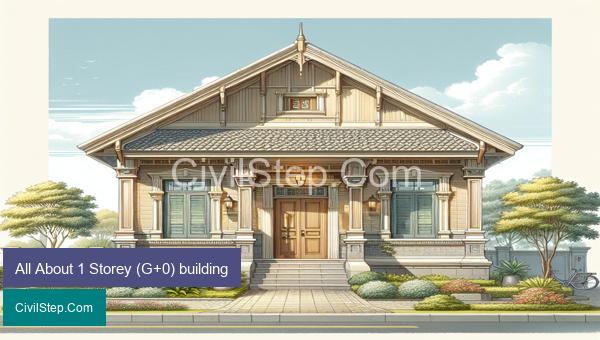
Building design and construction have come a long way in the past century, with various types of structures being developed for different purposes. One type of building that has been gaining popularity in recent years is the single-storey building, also known as G+0. Despite their simplicity, these buildings offer a unique set of advantages and challenges that make them an interesting subject to delve into. This article aims to provide a comprehensive overview of the all-about-one-storey building, discussing its history, features, construction methods, and potential uses. Whether you are a budding architect, curious homeowner, or simply interested in the world of construction, read on to discover more about this versatile building type.
Full reinforcement details for 1 Storey (G+0) building

A full reinforcement detail for a one-storey (G+0) building is essential for ensuring the structural stability and safety of the building. Reinforcement refers to the process of adding steel bars, also known as rebars, to concrete structures to improve their strength and durability. In this article, we will discuss the full reinforcement details of a one-storey building, including the types of rebars used, their spacing, and placement, and the factors to consider while designing the reinforcement.
Types of rebars used:
The type of rebars used in a one-storey building are mainly mild steel bars, also known as MS bars. MS bars are the most commonly used rebars for construction purposes due to their availability, strength, and cost-effectiveness. In some cases, high-strength rebars such as TMT (Thermo-Mechanically Treated) bars may also be used in specific structural elements that require higher strength.
Spacing of rebars:
The spacing of the rebars depends on the type of structural element and the design requirements. For columns and beams, the spacing of rebars is generally kept at 4 to 6 inches (100 to 150 mm) center to center. In the case of slabs, the spacing may vary from 6 to 12 inches (150 to 300 mm) depending on the slab thickness and the load it is expected to bear.
Placement of rebars:
The placement of rebars is crucial for ensuring the structural integrity of the building. For columns, the rebars are placed vertically, starting from the foundation and extending up to the top of the column. The spacing between the rebars is uniformly maintained along the length of the column. Similarly, for beams, the rebars are placed horizontally at the bottom of the beam and are uniformly spaced. In slabs, the rebars are placed in a grid pattern, with the spacing varying according to the design requirements.
Factors to consider while designing reinforcement:
1. Structural design: The reinforcement details should be designed according to the structural design of the building, which takes into account the expected loads and forces that the structure will have to resist.
2. Building codes and standards: The reinforcement details should comply with the building codes and standards set by the local authorities to ensure the safety and structural stability of the building.
3. Type of foundation: The type of foundation of the building plays a vital role in determining the reinforcement details. The reinforcement in the foundation should be designed to transfer the loads from the superstructure to the ground.
4. Climate and environmental factors: The reinforcement details should also consider the climate and environmental factors of the construction site, such as wind, seismic activity, and corrosion potential, which may affect the strength and stability of the building.
5. Construction process: The reinforcement details should be designed taking into account the construction process and methods used to ensure ease of construction and to avoid any on-site issues.
In conclusion, the full reinforcement details for a one-storey building are designed to provide adequate strength and stability to the structure. The type of rebars used, their spacing, and placement, as well as various design factors, should be carefully considered to ensure the structural integrity and safety of the building. It is essential to follow the design and specifications meticulously while constructing to maintain the structural stability of the building.
Conclusion
In conclusion, the one-storey or G+0 building has been gaining popularity in the modern construction world for its simplicity, flexibility, and affordability. This type of structure offers a variety of design options and can cater to diverse needs, whether it be for residential, commercial, or industrial purposes. Moreover, it provides an ideal solution for areas with limited land availability and can be easily expanded in the future if needed. With advancements in technology and materials, G+0 buildings can also be constructed with sustainable and environmentally friendly features. Overall, the one-storey building has proven to be a successful alternative to multi-storey structures, making it a valuable asset in the construction industry.
